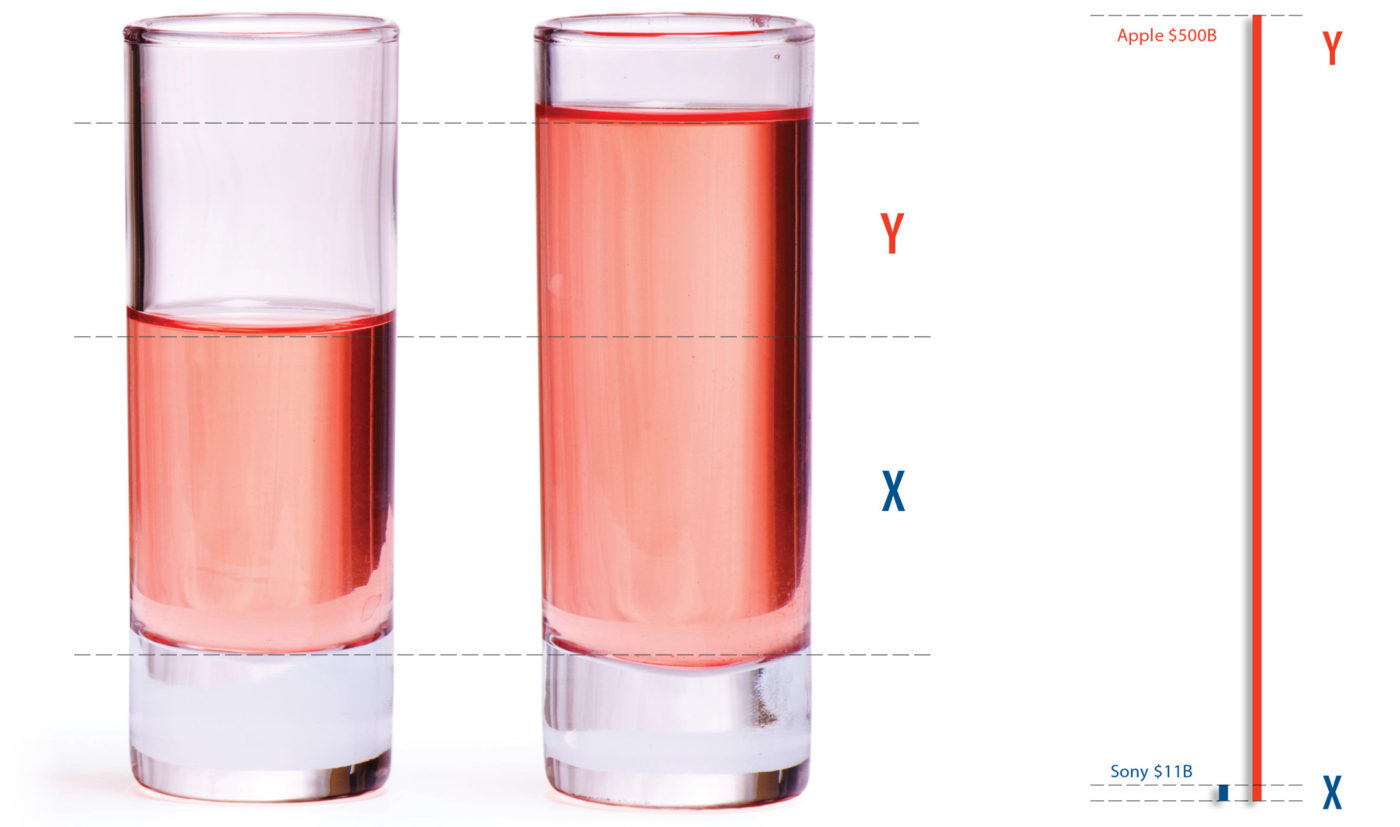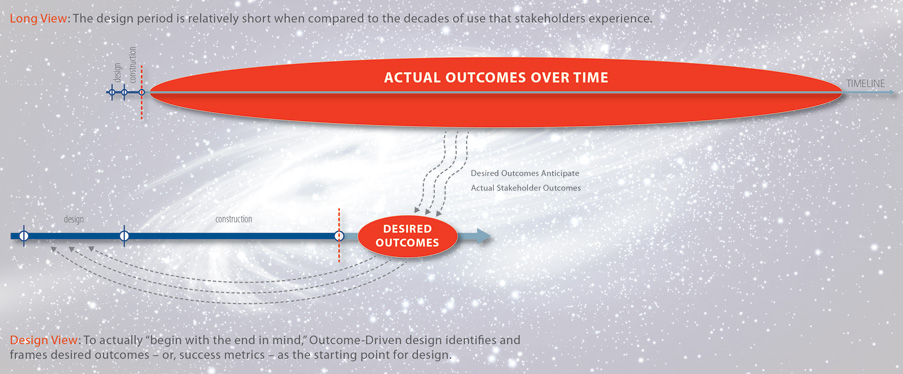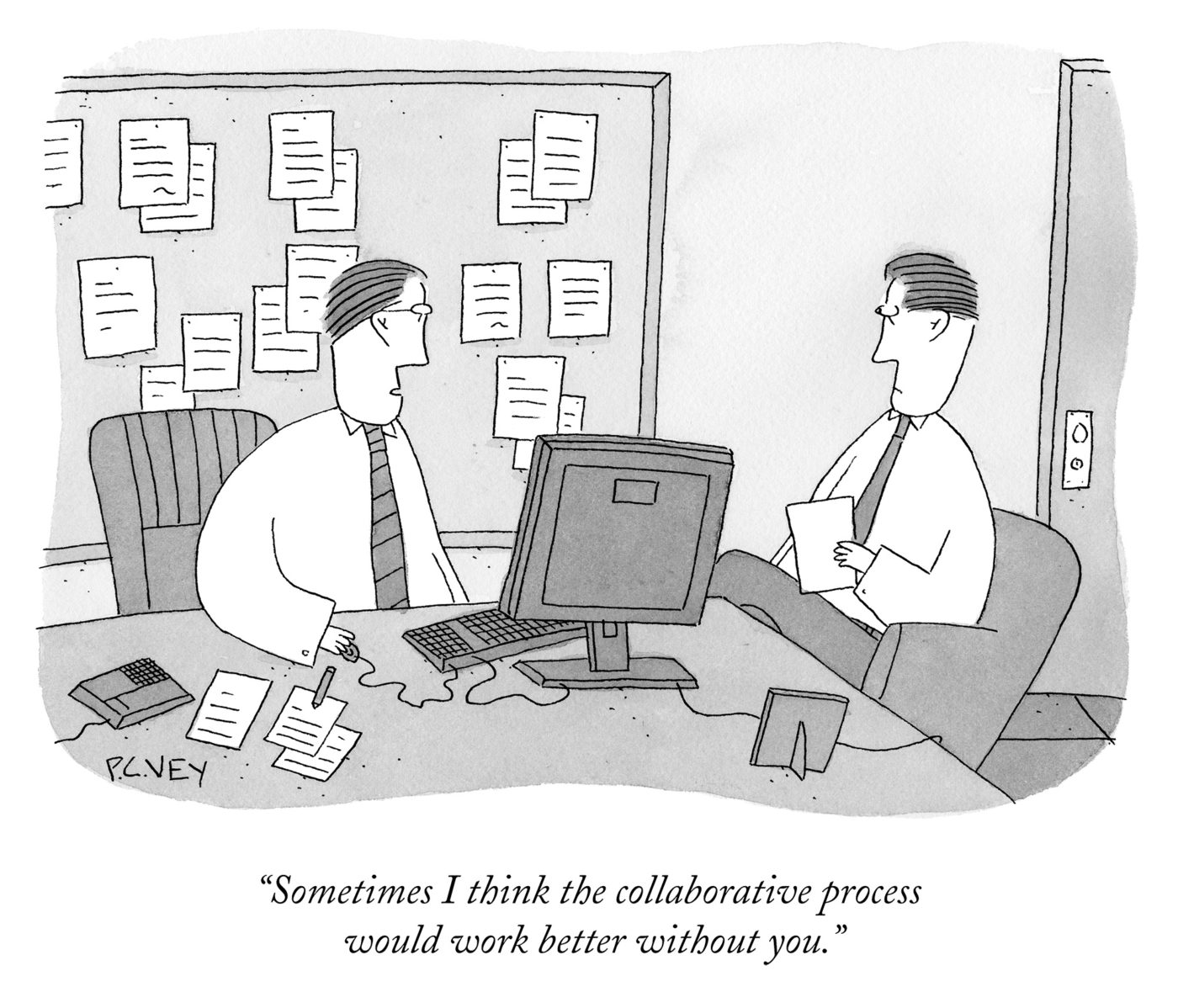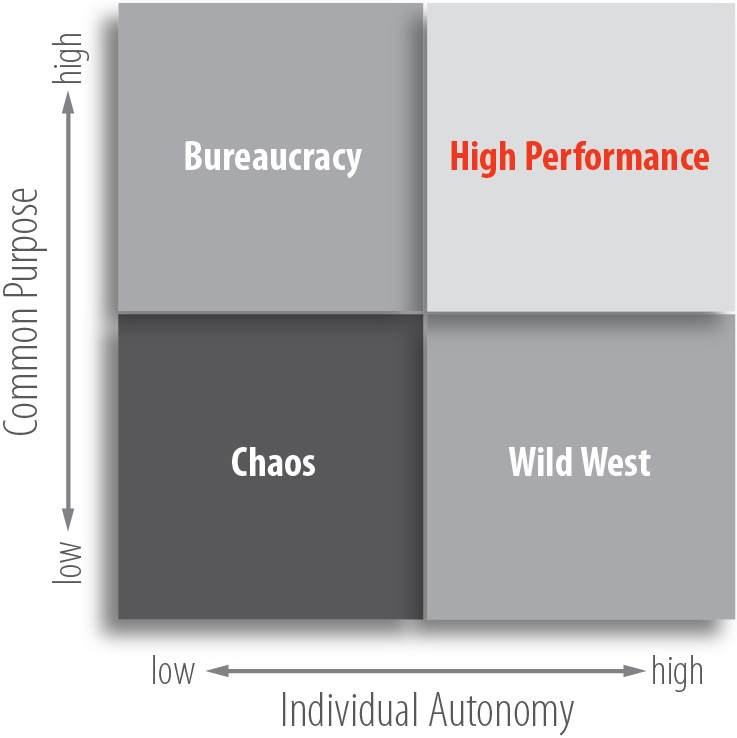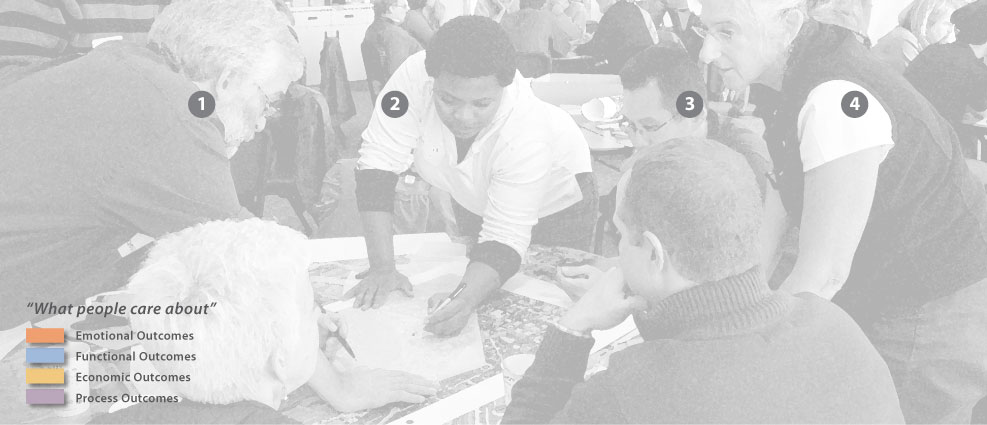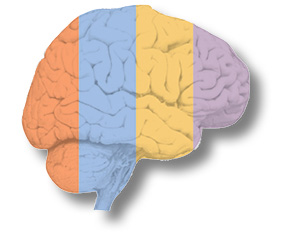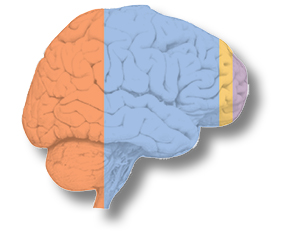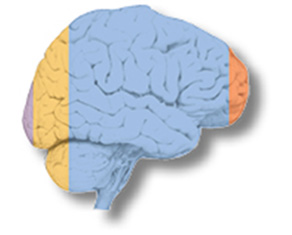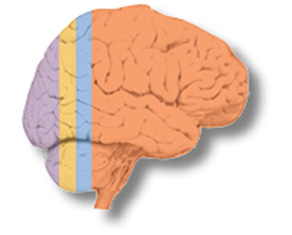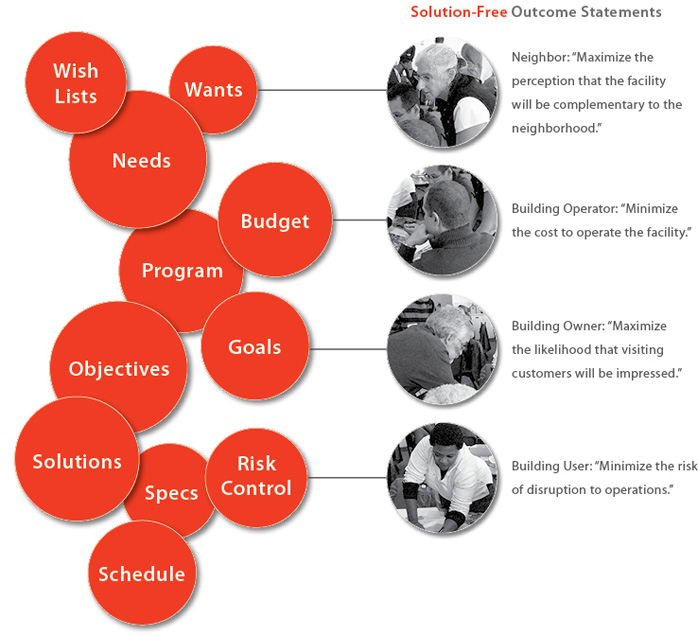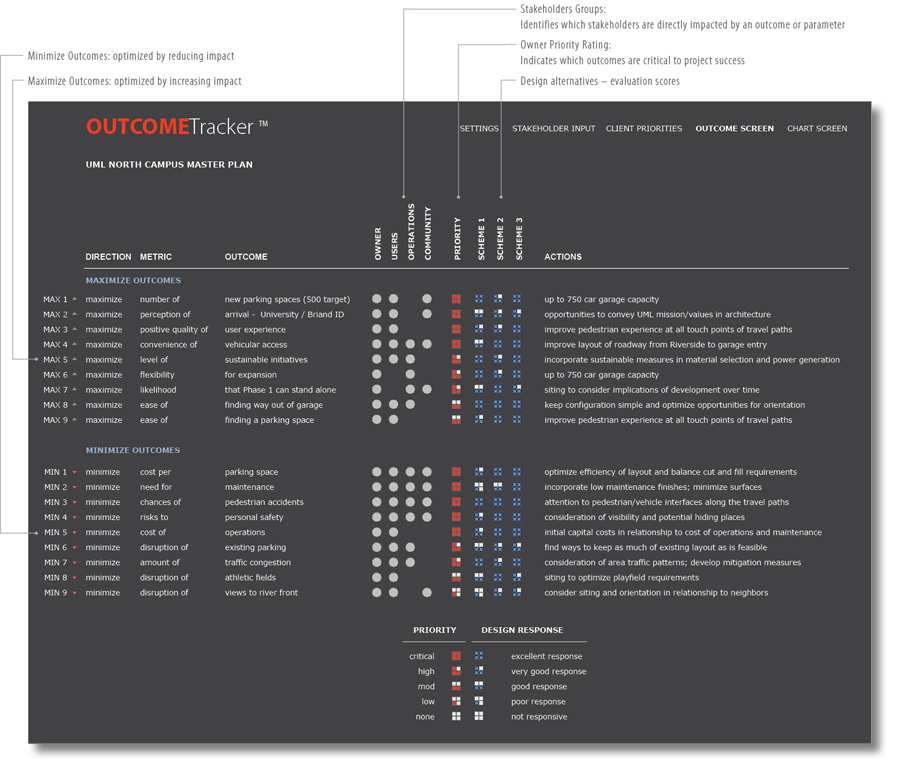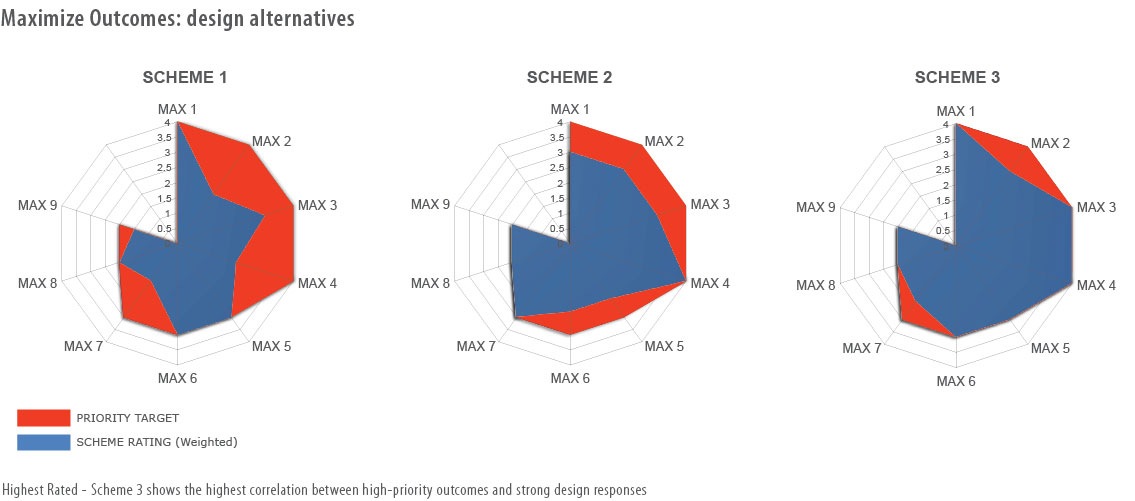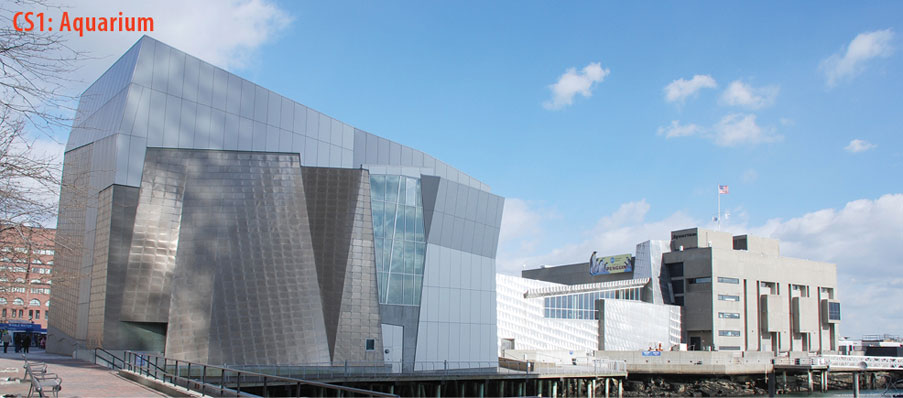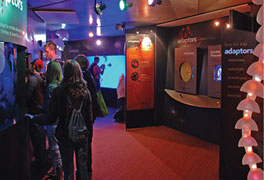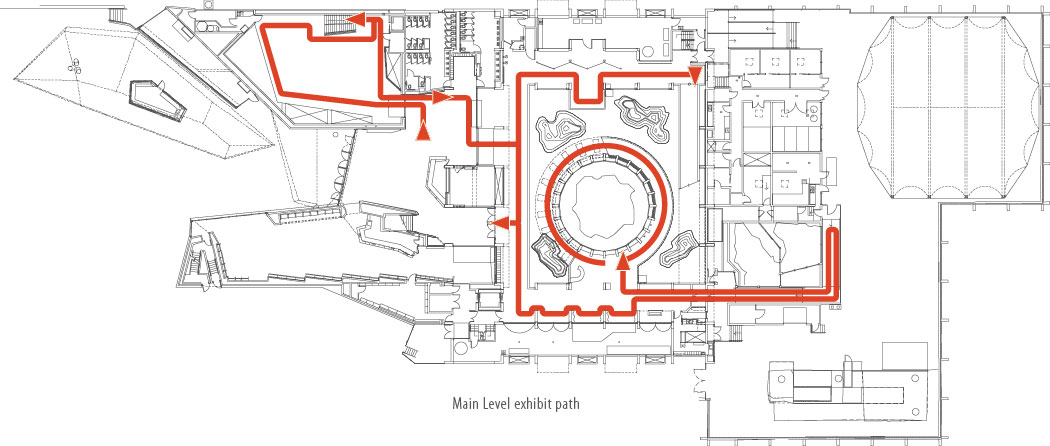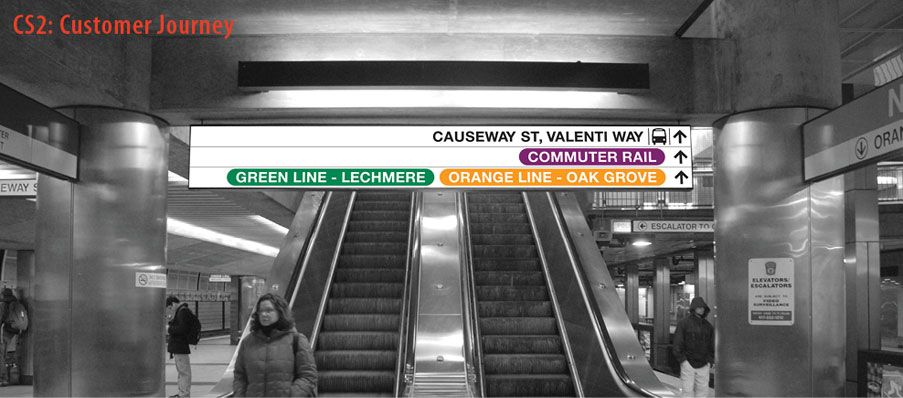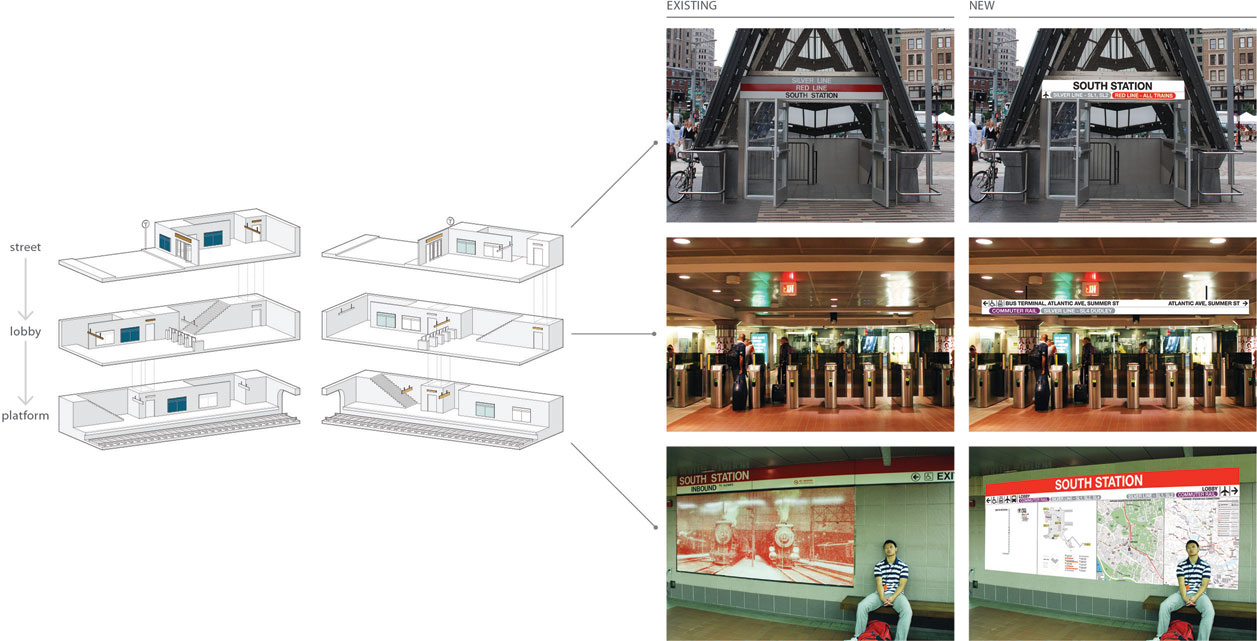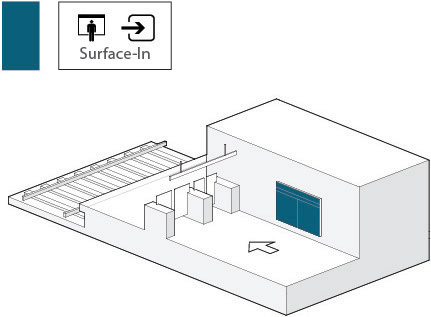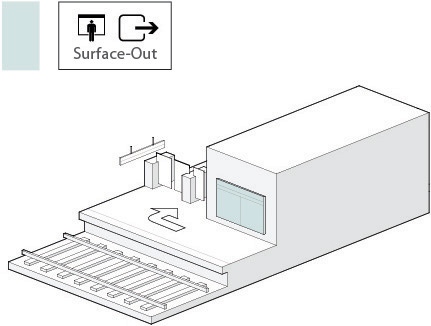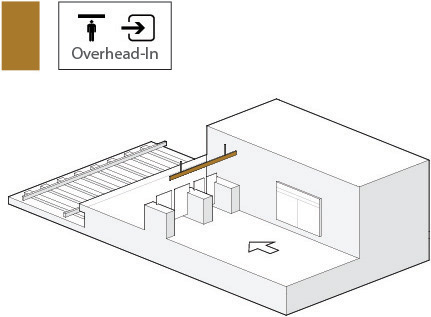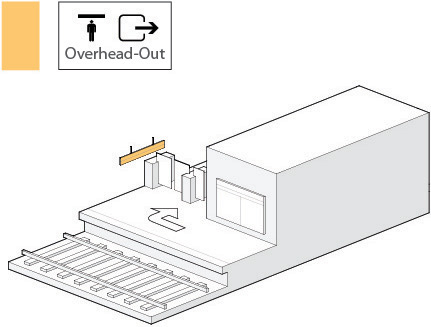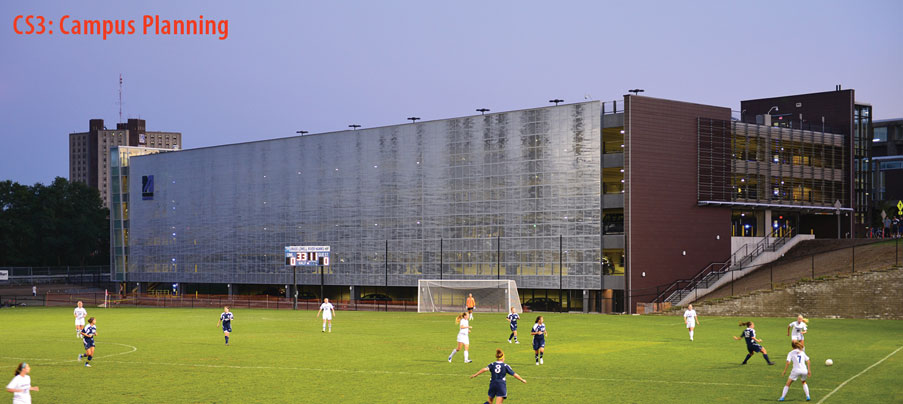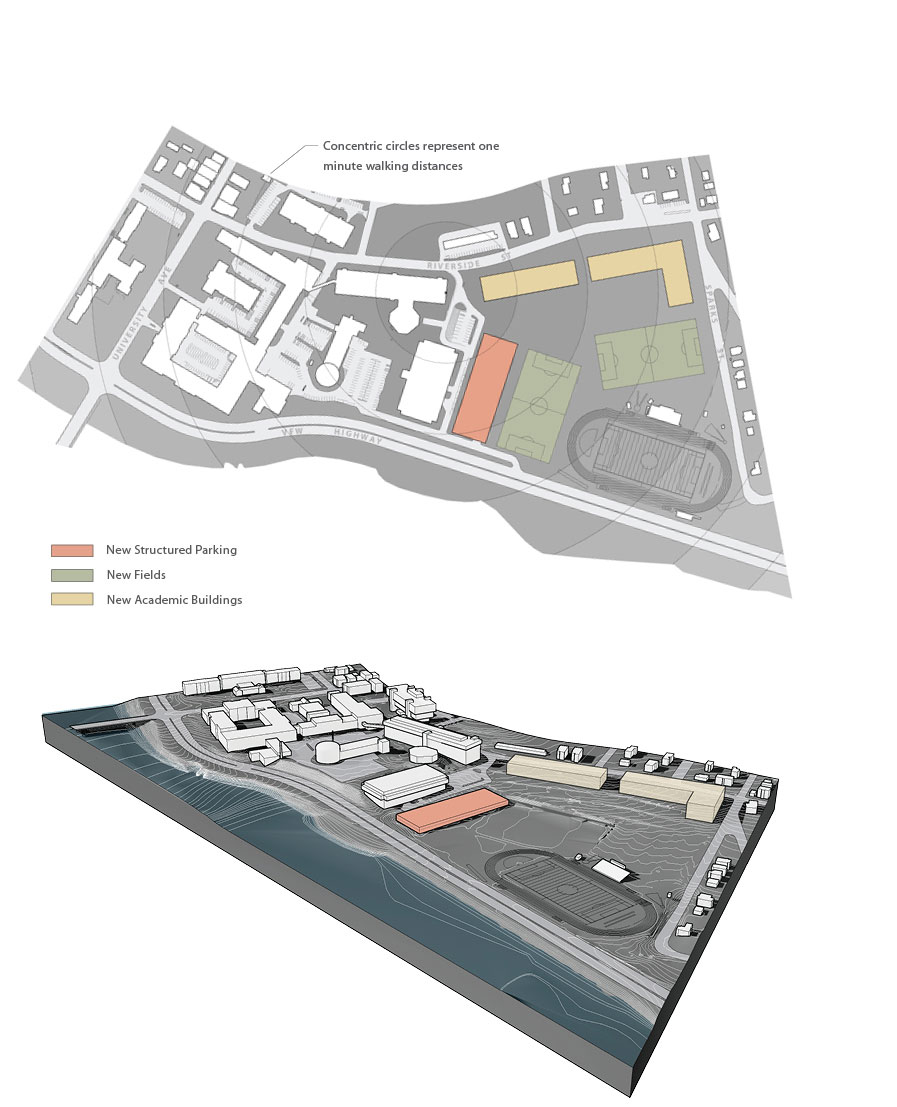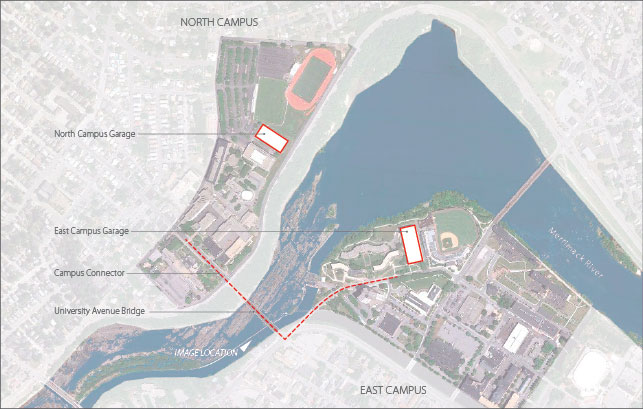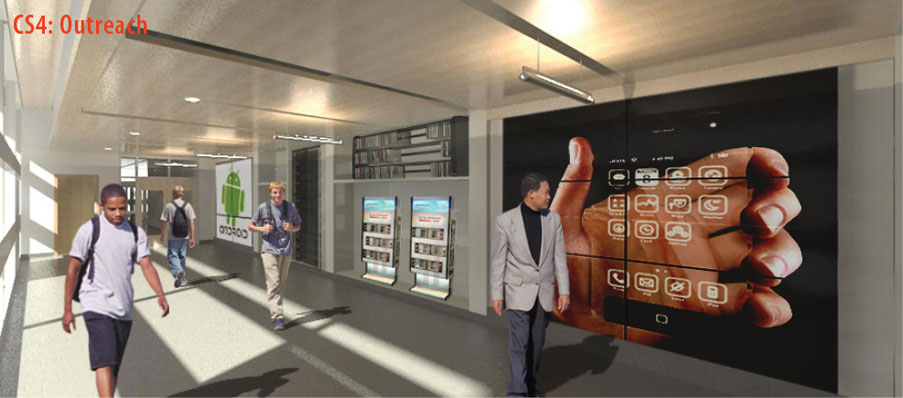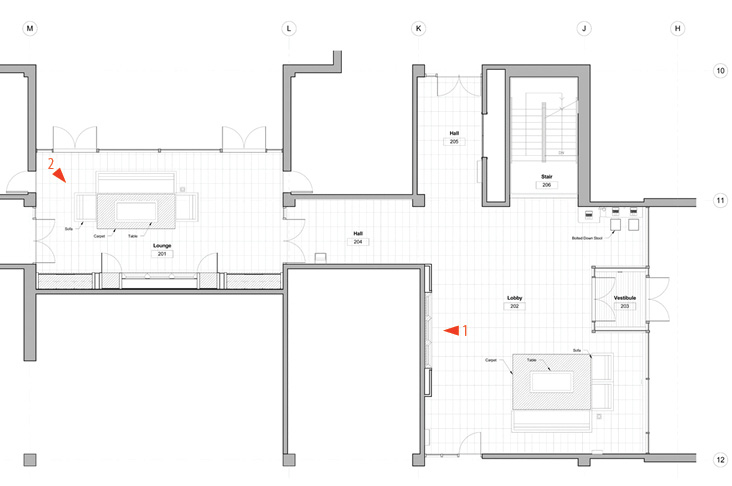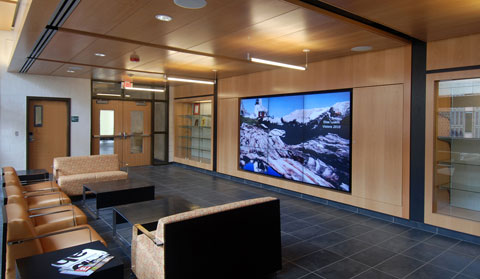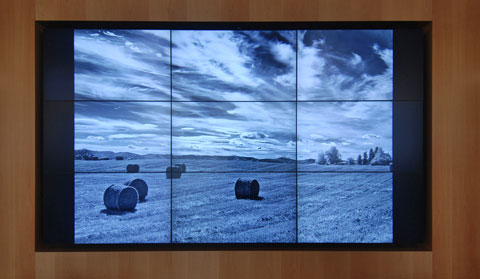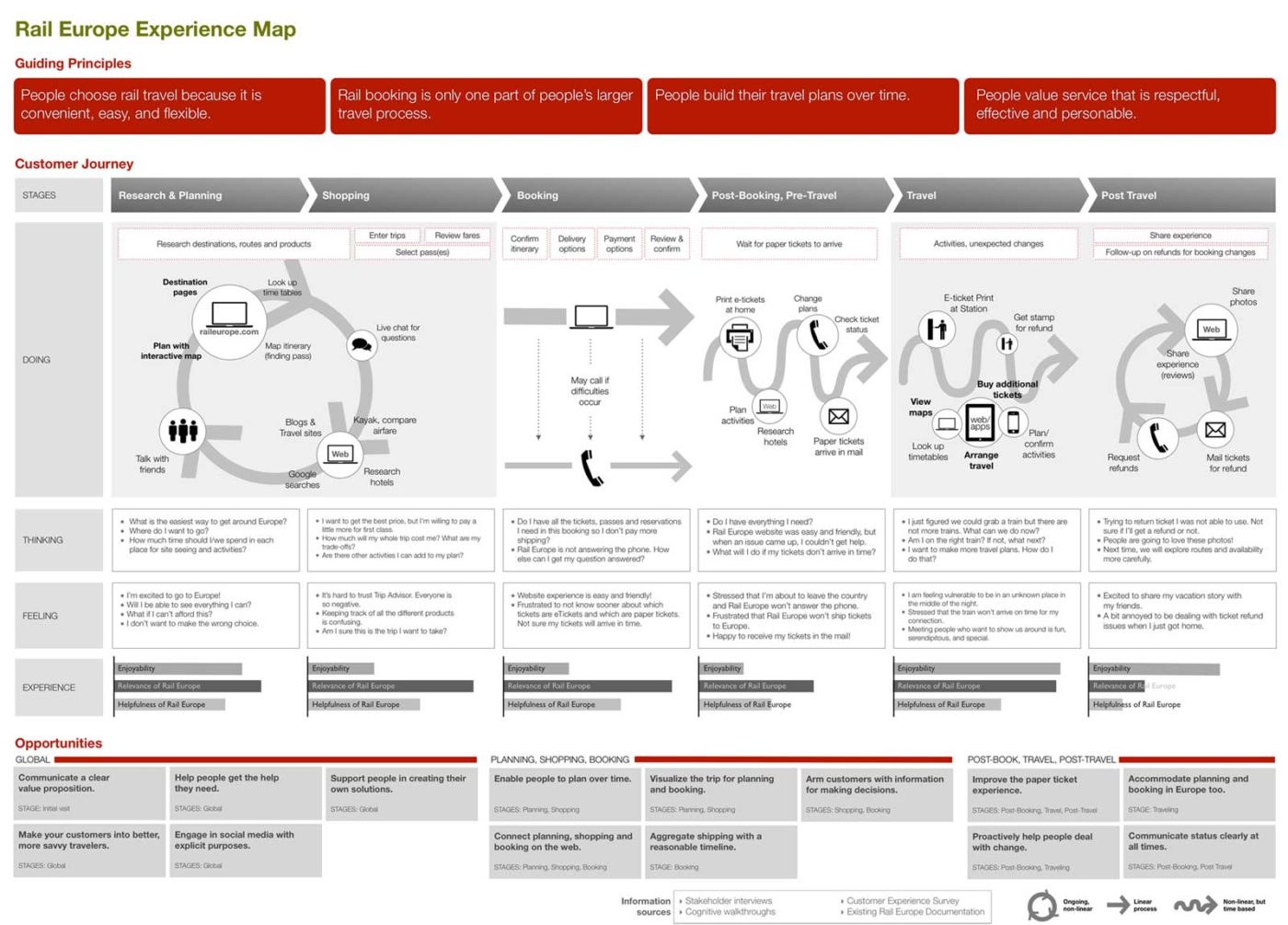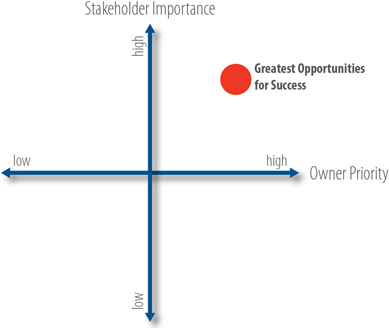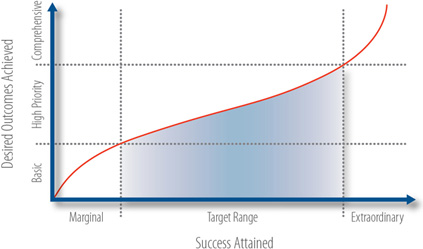BIA.studio is the originator of Outcome-Driven design (ODD), a framework for including diverse stakeholder perspectives in the design process.
Drawing on innovation techniques developed in other creative industries, Outcome-Driven design equips project participants with a methodology for maximizing project success. Understanding stakeholders’ desired outcomes provides the key insights needed to create truly responsive design solutions.

-
Maximizing Value – why ODd matters
Outcome-Driven design is a reliable way to create value in architecture. It’s a disciplined design process, fueled by the insights and desired outcomes of owners and project stakeholders.
Designers of products and services must have a laser focus on customer outcomes to succeed. In contrast, the practice of architecture has lacked an objective framework for identifying stakeholders’ desired outcomes. As a consequence, design solutions sometimes fail to deliver meaningful results, potentially missing opportunities to address important stakeholder concerns.
Using Outcome-Driven design as a framework, we actively engage stakeholders in the decision-making process, uncovering those outcomes most important to project success, as seen through their eyes. Knowing in advance the answer to the question, “What defines success?” enables our design process to be inspired by real needs, which may not be necessarily surface in a traditional design approach.

Achieving X
Typically, project success is measured by how well cost, schedule, and program requirements are met.
Achieving X+Y
Outcome-Driven design projects go beyond X to embrace a broader range of outcomes. Y represents the potential to achieve greater success.
Analogy: Sony versus Apple
Both are consumer electronics companies offering similar products to the public. Apple, however, is currently 50 times higher in market value due to their extraordinary focus on understanding what their customers’ desired outcomes are.
The Y value makes all the difference – nearly 50 times better.
-
Beginnings – start with the end in mind
In the long life of a building, the day-to-day outcomes of its occupants compound over decades of use. The premise of Outcome-Driven design is to identify and frame stakeholders’ desired outcomes, which are forecasts of the outcomes that will be critical to occupant success over time. Outcome-Driven design anticipates the future by uncovering desired outcomes at the beginning of the design process.
“Begin with the end in mind.”
– Stephen Covey
-
Collaboration for Success – how teams work

Outcome-Driven design is a framework for helping teams collaborate.
Two Poles of Collaboration
The ultimate success of a team (as the rowers above illustrate) requires alignment, common purpose, and individual autonomy. Consistently successful teams always exhibit these characteristics. Sub-optimal collaboration occurs in organizations that are not organized to align individual performance with larger objectives. The characters in the cartoon could occupy any quadrant of the 2×2 matrix, with the exception of the upper right.


Collaboration 2×2
In the same way that competitive teams are optimally aligned, the aim of Outcome-Driven design is to help project owners and stakeholders visualize what high performance is: strong commitment to common purpose in concert with individual autonomy.
-
Stakeholder Perspectives – how to be inclusive
Customers of products and services are defined by the needs they have in common. Architectural project stakeholders, by contrast, often have divergent needs and aspirations. Understanding individual perspectives is the starting point for engaging owners and stakeholders in conversation about their success factors.


1. Building Owner/Client Group
There are many different kinds of client structures. Frequently they work as a team: executive client, funding authority, and client management interface for executing the project. Owners have the broadest set of desired outcomes, as their success depends on balancing issues across all facets of a project. Relative importance will vary, but all 4 outcome areas are usually important to owners.

2. Building Users
This is the core constituency that a building is targeted to serve. This includes patrons, staff, visitors, and any other group of people that the building is specifically designed to serve. The most important outcomes for building users are related to functional and emotional activities. To a lesser extent there may be facets of financial and process outcomes that are important.

3. Building Operators
These are the people who run and maintain the completed building. This group includes facilities personnel, support staff, and external personnel involved with building operations. The issues important to this group are weighted towards functional and financial outcomes.

4. External Constituents
These are people affected indirectly by a project. They are neighbors, a precinct, or a larger region. The interests of external constituents are often focused on emotional outcomes about how the project will affect them. They may also be concerned with economic and process outcomes.
-
Extraction– identifying drivers
Project criteria comprise hundreds, if not thousands of requirements, objectives and goals. From this ocean of information we extract the outcomes that stakeholders report are most important and critical to success. These are the true drivers of design, actionable through the framework of Outcome-Driven design, which manages group decision-making over time.

-
Outcome Tracker – software for decision-making
The Outcome Tracker software organizes outcomes into a comprehensive framework that tracks the performance of design alternatives against desired outcomes. This allows for a simple but comprehensive view of project success metrics like no other tool.
Outcome Tracker also provides visualization graphics to highlight performance differences between design alternatives and the project’s desired outcomes. The red color indicates target priorities for each outcome, while the blue represents stakeholder scoring of each design alternative. The relative success of a design alternative is revealed by blue/red divergence – the less red showing, the better the design solution has addressed an outcome.


-
Case Studies – four exemplary projects
Our framework can be applied to any design or decision-making activity, and is particularly effective in group settings. Shifting the focus of decision-making from solutions to outcomes helps project stakeholders communicate about what is important to them as end results, and how they want to feel about the finished project.
The following case studies illustrate how Outcome-Driven design has been applied to different design challenges. In each case, the process has revealed outcome criteria that would not have surfaced in a typical design process. The innovative solutions that have emerged for each project are the direct result of a process that looks to understand what is really important to long-term success.
-
CS1: Aquarium – Enticing Visitors to become stewards of the planet

For the New England Aquarium, we developed an Exhibit Master Plan to optimize the different types and levels of learning that are possible within the facility. The result is a system of “Learning Outcomes” that helps the aquarium prioritize and shape the visitor experience.
High-Level Desired Outcomes
Orchestrate the aquarium experience and learning opportunities to encourage visitors to become members and get involved with stewardship of the Blue Planet.Metrics
Track number of visitors over time who report engagement in stewardship initiatives.
Framework: 4 kinds of learning outcomes

Emotional/Intuitive
Provide experiences that visitors will absorb through their senses. Visitors will describe these encounters as beautiful, enchanting, fascinating, surprising, unexpected, intriguing, moving, etc.
Cognitive
Provide opportunities for visitor engagement that will increase their knowledge and understanding of marine life and environments through interaction and interpretive activities.
Empathetic
Through live animal presentations and human interaction, Increase the likelihood that visitors will feel empathy for marine life, marine environments, and the people who work in this field.
Self-Aware/Reflective
Provide experiences that motivate and inspire visitors to become aware of their individual impacts on marine life and environments, and to become involved in stewardship on any level.


Exhibit Path of the Aquarium’s Main Floor (top) with a partial storyboard view of the exhibit components (above) -
CS2: Customer Journey – Clarifying a wayfinding system to promote customer navigation

Redesign of the entire wayfinding approach of the MBTA system, based on the concept of “customer journey.”
High-Level Desired Outcomes
Increase likelihood that students will interact and serve to increase awareness of “what’s happening” within the creative departments of Conlon Hall.Metrics
Post-occupancy observation of space utilization; student, faculty, and visitor feedback on display programs using social media to measure engagement, evaluation, and sharing trends.

Sign Types

The Surface-In sign communicates the line and station identification. The Surface-In sign may include a single or combination of the following maps: Line of System (Inbound, Outbound or All), Rapid Transit Line, and Commuter Rail.

The Surface-Out sign communicates the station identification, transfer line, and destinations applicable to that path. The Surface-Out sign may include a single or combination of the following maps: Bus Route, Neighborhood, Neighborhood Bus, You Are Here Busway, and You Are Here.

An Overhead-In sign communicates line and station identification. The Overhead-In sign occurs over the various entrance points into a station and where the path splits for entry onto a platform.

The Overhead-Out sign communicates the exit and transfer line destinations. The Overhead-Out sign occurs at decision points, such as where the path splits from the platform combined path to the platform ambulatory and accessible paths. Overhead-Out signage is also used where there is a lack of adjacent surface signage.
-
CS3: Campus Planning – Projecting a new brand image

This planning study for UMass Lowell utilizes our Outcome Assessment software to identify important stakeholder criteria for the development of UML’s North Campus.
High-Level Desired Outcomes
Increase convenience of parking for university users and reduce stress on neighborhood residents caused by insufficient parking capacity on campusMetrics
Achievement of targeted net increase in parking capacity; monitoring of neighborhood complaints to verify decrease over time


UMass Lowell North Campus – planning for future development
Our study evaluates the northern portion of campus to determine the optimal solutions for academic building expansion, structured parking, and improved athletic fields. -
CS4: Outreach – Promoting student communication and visibility

Conlon Hall is the 40 year-old home of the Communications Media and Industrial Technology programs at Fitchburg State University. This project repurposes the main entry into a suite of public gathering spaces equipped with large, high-definition media walls programmed to showcase the work of students and faculty.
High-Level Desired Outcomes
Increase likelihood that students will interact and increase awareness of “what’s happening” within the creative departments of Conlon Hall.Metrics
Post-occupancy observation of space utilization; student, faculty, and visitor feedback on display programs using social media to measure engagement, evaluation, and sharing trends.
-
CS1: Aquarium – Enticing Visitors to become stewards of the planet
-
Outcome-Oriented Practices – insights from innovators
Several creative industries have revolutionized design effectiveness by adopting outcome-oriented methods. Our Outcome-Driven design process is indebted to the thinking that has evolved from this diverse group of innovators:

Outcome-Driven Innovation
Strategyn has pioneered a highly successful outcome-driven methodology for innovating new products and services. As most companies find that 70-90 percent of their innovation initiatives fail, this rigorous process helps eliminate randomness and uncertainty, and provides a clear framework for dramatically increasing the success rate of innovation projects. Discovering unmet customer needs and desired outcomes is the key.

Understanding by Design
This increasingly popular tool for educational planning focuses on “teaching for understanding”. The emphasis of UbD is on the concept of “transfer”, the practice of looking at desired outcomes in order to design curriculum units, performance assessments, and classroom instruction. The UbD framework was designed by nationally recognized educators Grant Wiggins and Jay McTighe.

Experience Design
The practice of designing products, services, events, and environments based on the consideration of people’s needs, desires, and perceptions. Experience design is driven by understanding the “moments of engagement,” or touchpoints between people and brands, and the ideas, emotions, and memories that these moments create. Desired outcomes provide a framework for orchestrating experiences over time.

-
Concepts – the components of success
The terminology of Outcome-Driven design draws on concepts originally developed for the design of products and services. We have adapted these concepts to architecture with the aim of improving building performance for people.
Benefit: the tangible advantage that an individual or group realizes within a design attribute of the built environment.
Building Owner: the group of individuals or entities that represent the interests of the owner. This includes legal owners, funding authorities, and owner representatives.
Cluster Analysis: an analytic technique that finds convergence between stakeholders’ desired outcomes and the building owner’s priorities. This is used in outcome-driven analysis to identify areas of owner/stakeholder agreement.
Constraint: a hindrance that prevents an individual or group from being able to accomplish an activity under certain circumstances. Being unable to have a private conversation in an office setting is an example of a constraint.
Convergence: project criteria that are rated as “important” by stakeholders and a high “priority” by owners. The greatest opportunities for design response are found under these conditions.

Emotional Outcomes: how an individual feels about their environment in relation to their activities. Emotional outcomes are subdivided into personal activities (how one feels about their personal experience) and social perspective (feelings related to how one wants to be perceived by others).
Functional Outcomes: the measurable result of activities undertaken by an individual or group. A positive outcome would be “worker productivity increased due to the introduction of natural light and exterior views in all work spaces.”
Importance Rating: the numerical value that an individual or group gives an outcome statement to rate the level of outcome importance.
Integrated Design: the principle that design value is optimized when the design team works closely from the very beginning. The technical outcomes of architecture benefit from the expertise of building systems design involved early in the design process.
Opportunity: an outcome, activity, or constraint that is important to both owner and stakeholder and is identified as a target for design.
Outcome: a metric that an individual or group uses to measure how well building design serves an activity they need to get done. Outcomes represent people’s fundamental measures of building performance and can be easily translated into project criteria.
Outcome-Driven Design: an orientation to architecture that requires the design team to understand what the building owner/stakeholder group wants before beginning design.
Outcome Statement: a consistent grammatical format for expressing desired outcomes. A statement includes a direction (increase or minimize), a measure (number of, amount of, time it takes, etc.), and an outcome subject (sunny exterior space, rooms with views, etc.).
Parameters: are the hard criteria that define a project’s fixed aspects, such as size, quantities, costs, schedule, etc. Parameters are absolute inputs, which differ from the relative inputs of outcomes (like the difference between a radio’s on/off switch – an absolute, and its tonal controls – which are adjustable and graduated).
Priority Rating: the numerical value that owners apply to stakeholders’ outcome statements. The value of any stakeholder outcome is validated or invalidated by the owner’s priority rating.
Responsive Design: the process of identifying highly-rated and important outcomes which create a framework for focusing the design process.
Satisfaction Rating: a numerical rating of how satisfied an individual or group is that an outcome is well-served.
Stakeholders: a general term inclusive of all people and entities with an interest in the outcomes of the project. For organizational purposes we utilize four broad categories of stakeholders: owners, users, operators, and external constituents.
-
10 Reasons – what ODD can deliver
Here are ten ways that our Outcome-Driven design process works to achieve better results.
01 Time Travel
Every project concludes in outcomes (desired or not). Mentally travel to the future to establish what outcomes are important, before design starts.
02 Sharpen Decisions
Sharpen Decisions by clearly understanding what outcomes are important to success, it is much easier to manage scope and remain focused on productive design solutions.
03 Predictable Results
Outcomes are predictive of final results. Use outcomes to manage expectations.

04 Innovative Solutions
The Outcome-Driven design process is truly innovative. The methodology is successfully employed in product and service design to achieve breakthrough results.
05 Inclusive Process
An effective way to include stakeholders in the design process and eliminate counter-productive inputs.
06 Creative Participation
Outcome-Driven design provides techniques for keeping stakeholders actively involved in evaluation of the creative process.
07 Clarity
When project requirements are stated as either parameters (fixed requirements), or as outcomes (optimizable results), clarity results. This is a superior evaluation tool for judging how well design solutions respond to priorities.
08 Leverage Change
Every building project is a catalyst for change. Outcome-Driven design provides a framework for charting a path that allows owners and stakeholders to decide what aspects of change are worth pursuing.
09 Time Travel
The Outcome-Driven design framework improves communications among stakeholders and project team members by providing an open-source road map for navigating the decision-making process.
10 Satisfied Stakeholders
At the outset, stakeholders are asked not to focus on solutions but to think through what outcomes they require to be successful. When design solutions grow from this focus, the result is more responsive design and a higher level of satisfaction among owners and stakeholders.
